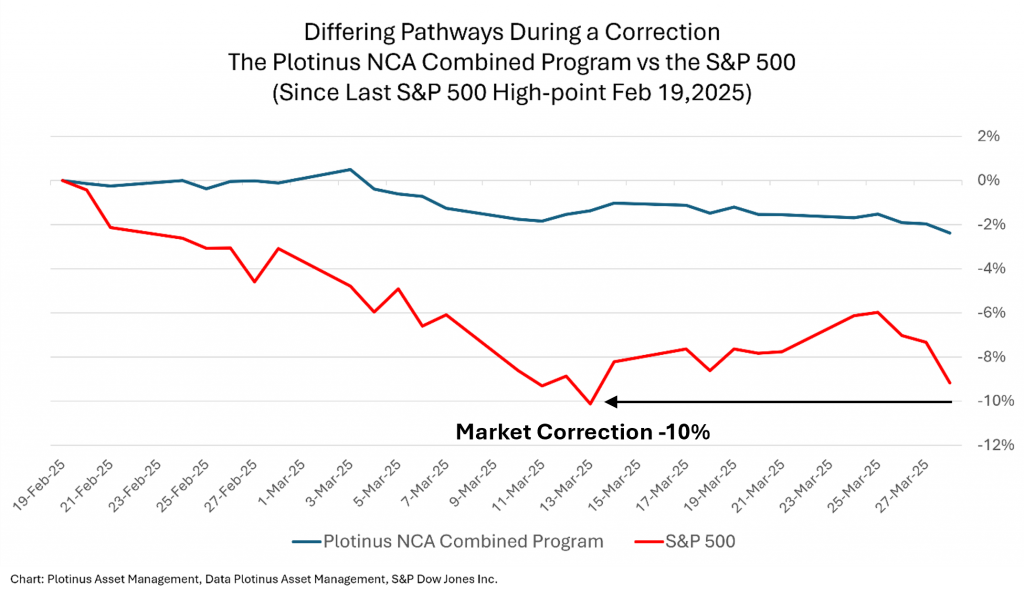It is probably just as well that “Liberation Day” falls on April 2nd and not a day earlier, which would just add more confusion were it to share the occasion with April Fools’ Day. The past month has shown just how hard the markets have found it to work out who is fooling who, trying to figure out the impact of the raft of US tariff announcements (and stays of execution) emanating from the White House.
The US stock markets have truly been rattled. Since the new administration came into office, the Nasdaq landed in a correction, the S&P 500 skirted momentarily with one and the small caps Russell is threateningly close to bear market territory. At time of writing, with one trading day left in March, all the major indices are significantly down, the Dow -5.1%, the S&P 500 -6.3%, the NASDAQ -8.1% and the Russell -11.7% in March alone.
The raw returns however only tell part of the story. What has been most notable has been the turbulent lurches of the markets with every new hint of tariff news. The table illustrates the marked change in daily price swings.

The trouble has not been restricted to the equity markets either. The US dollar has taken a hammering over the same time period, for example, losing -5% against the British pound and -4.2% against the Euro. Since the potential outcomes of US tariff policies span from it being a rouse as a part of a broader geopolitical negotiating tactic, to the start of a full blown global trade war, the inability to figure out the consequences of the tariffs policy is understandable.
Can AI Trade Decision-Making Provide Any Solutions in Such Volatile Conditions?
Plotinus has in recent months been expanding its line of Non-Correlated Alpha investment products. In addition to our single instrument NCA US 500 trading S&P 500 futures, we are now also offering an NCA US Tech 100 trading Nasdaq futures and the NCA Combined program trading S&P 500, Nasdaq, Dow, Russell 2000 and Eurostoxx 50 futures. The aim of these programs is to provide over the long-term a similar level of return to a US equity index, generally non-correlated (based on monthly returns), with significantly lower volatility and smaller drawdowns.
The current whip-sawing markets are far from ideal conditions for our trading programs, and they have experienced losses during the current market turmoil. Let us look at the profile of those returns in comparison with the market.

The most obvious observation is that whilst the Plotinus NCA Combined program has clearly had losses, those losses have been significantly curtailed when compared with the S&P 500. So, from a drawdown perspective the AI driven program is fulfilling one of its objectives. From a volatility standpoint, the annualized volatility (based on daily returns) for this period for the S&P 500 has been 19.7% whereas this is only 5.3% for the Plotinus NCA Combined program. The AI driven strategy is therefore also living up to expectations by providing a lower volatility. Finally, looking at correlation, this of course is a very short period of time, not sufficient to study monthly correlations but if we look instead at the correlations of daily returns, the Plotinus NCA Combined program has a correlation of 0.27 with the S&P 500, very much in keeping with its aim to be generally non-correlated.
With “Liberation Day” beckoning it seems highly unlikely that it will bring with it any liberation from uncertainty for market participants. In these novel times, traditional old safe havens cannot be viewed with the same traditional thinking. In that context, it is worth considering looking to new types of investment strategies such as our AI trade decision-making one, to assist in managing these volatile conditions.
Please contact Plotinus Asset Management for further information on Plotinus’ expanded range of Non-Correlated Alpha programs. ■
© 2025 Plotinus Asset Management. All rights reserved.
Unauthorized use and/or duplication of any material on this site without written permission is prohibited.
Image Credit: Fran_kie at Shutterstock.

